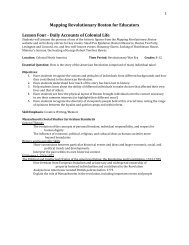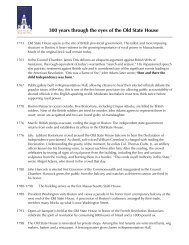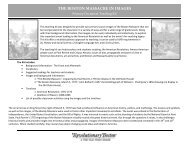Sweet History: Dorchester and the Chocolate ... - Bostonian Society
Sweet History: Dorchester and the Chocolate ... - Bostonian Society
Sweet History: Dorchester and the Chocolate ... - Bostonian Society
You also want an ePaper? Increase the reach of your titles
YUMPU automatically turns print PDFs into web optimized ePapers that Google loves.
SWEET HISTORY: <strong>Dorchester</strong> <strong>and</strong> <strong>the</strong> <strong>Chocolate</strong> Factorywww.bostonhistory.org/bakerschocolate/Henry Pierce HouseBuilt around 1800, <strong>the</strong> Federal-style house at 1133 Washington Street was bought byHenry Pierce’s parents, Jessie <strong>and</strong> Elizabeth, in 1849. Located close to <strong>the</strong> Baker’scomplex, Henry lived here to remain near company operations. 58Employee HousingIn <strong>the</strong> late nineteenth century <strong>and</strong> early twentieth century, most of Baker’s employeeslived close to <strong>the</strong> mills. The neighborhoods of Lower Mills East <strong>and</strong> Lower Mills Westhoused many of <strong>the</strong> people working at Baker’s, <strong>and</strong> were characterized as middle class<strong>and</strong> working class, respectively. While most workers rented rooms for <strong>the</strong>mselves ormulti-unit houses for <strong>the</strong>ir family, some employees eventually owned <strong>the</strong>ir homes. Manyof <strong>the</strong> two-story houses that employees lived in still survive. The greatest concentrationof buildings still st<strong>and</strong>ing today can be found just northwest of <strong>the</strong> mill buildings onSanford, Sturbridge, Monson, Temple, Old Morton, River, Cedar, Idaho, <strong>and</strong> Grovel<strong>and</strong>Streets. 59In <strong>the</strong> 1920s approximately 1,000 people worked in <strong>the</strong> Baker’s mills, <strong>and</strong> many livednear <strong>the</strong> mills in neighborhoods east <strong>and</strong> west of <strong>Dorchester</strong> Avenue <strong>and</strong> Adams Street.The structures colored in blue in <strong>the</strong> lower right corner indicate <strong>the</strong> Baker’s mill complex.Those marked in red show where, in 1920, many employees lived. 60The ArchitectsAs Baker’s <strong>Chocolate</strong> exp<strong>and</strong>ed <strong>the</strong>ir operations, new mill buildings were erected tohouse more facilities. The unified look of <strong>the</strong> Baker’s complex in <strong>the</strong> Lower Mills, despite<strong>the</strong> use of different architectural styles, derived from a long-term relationship with <strong>the</strong>architectural firm of Nathaniel J. Bradlee, Walter Winslow, <strong>and</strong> George H. We<strong>the</strong>rell.After Bradlee died, Henry F. Bigelow joined <strong>the</strong> practice. Located in Boston, <strong>the</strong> firm’scredits initially revolved around Bradlee’s reputation for his commercial downtownbuildings as well as row houses in <strong>the</strong> South End <strong>and</strong> Back Bay neighborhoods. As <strong>the</strong>firm evolved, <strong>the</strong>ir portfolio exp<strong>and</strong>ed to include prominent Boston buildings such as <strong>the</strong>Parker House Hotel, <strong>the</strong> Hotel Touraine, <strong>the</strong> Board of Trade building, <strong>and</strong> <strong>the</strong> Shawmut58 <strong>Society</strong> of Architectural Historians (New Engl<strong>and</strong> Chapter) et. al., “An Architectural Tour of <strong>the</strong>Roxbury <strong>and</strong> <strong>Dorchester</strong> Lower Mills Heritage State Parks <strong>and</strong> Their Neighborhoods,” 14 April 1985, 7; BostonL<strong>and</strong>marks Commission, “Lower Mills West Area Form, ” May 1995, copy posted at <strong>Dorchester</strong> A<strong>the</strong>neum[online]; available from http://www.dorchestera<strong>the</strong>neum.org/page.php?id=627; Internet, accessed on 9 Aug 2005.59 Anthony M. Sammarco, “Victorian Boston’s <strong>Chocolate</strong> Village,” Victorian Walking Tours Today:Twelve Walking Tours, ed. Mary Melvin Petronella (Boston: Nor<strong>the</strong>astern University Press, 2004) 199; 1920 U.S.census, Suffolk County, Massachusetts, population schedule, town of Boston, enumeration districts [ED] 522,sheets 1B-7A, ED 523, sheets 1A-16B, ED 524, sheets 1A-12A, ED 525, sheets 1A-9A, National Archives micropublicationT625, roll 739.60 1920 U.S. census, Suffolk County, Massachusetts, population schedule, Boston, EDs 522-525, NationalArchives micropublication T625, roll 739.20 of 76© 2005 The <strong>Bostonian</strong> <strong>Society</strong>. Nothing from <strong>the</strong> site can be reproduced without specific written permission issued by:The <strong>Bostonian</strong> <strong>Society</strong> • 206 Washington Street • Boston, MA 02109-1773. Any questions, call 617-720-1713.






